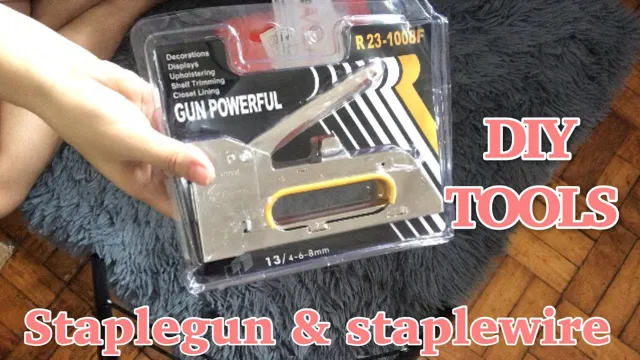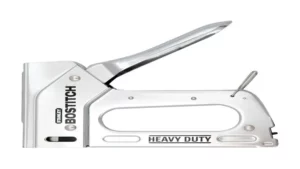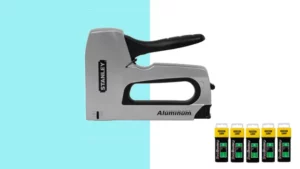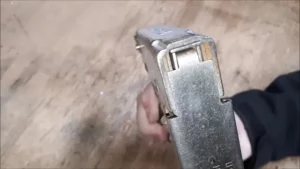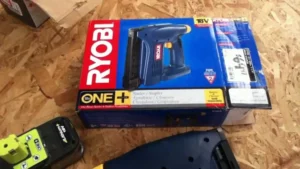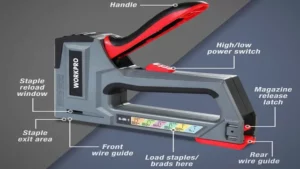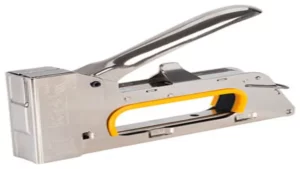Have you ever found yourself in a situation where you urgently need to reload your staple gun but have no idea how? If you’re new to the world of staple guns and find yourself struggling with this, don’t worry – you’re not alone! Although it may seem daunting, reloading a staple gun is a straightforward process that just takes a bit of practice. In this step-by-step guide, we’ll walk you through everything you need to know to successfully reload your staple gun, whether it’s for DIY projects or professional use. So, grab your staple gun and let’s get started!
Gather Your Tools
Reloading a staple gun is a simple task if you have the right tools. First, make sure you have compatible staples for your gun. Using the wrong size or type of staple could result in misfires or damage to your gun.
Next, use the proper safety gear such as gloves and eye protection. Open your staple gun and remove any remaining staples or debris. Insert the new staples into the magazine following the manufacturer’s instructions.
Be sure to push the staples all the way in and close the staple gun securely when you’re finished. With a little bit of practice, reloading your staple gun will become second nature. Remember to always handle your staple gun safely and responsibly.
You’ll Need Staples and Your Staple Gun
When it comes to DIY upholstery projects, having the right tools is essential. One of the most crucial tools is a staple gun. But don’t forget the staples themselves! You’ll want to make sure you have plenty on hand before starting your project.
A standard staple size for upholstery work is 1/4-inch leg length, but always check your upholstery fabric to confirm the correct size and gauge. There are also different types of staples to consider, such as galvanized or stainless steel, depending on the project requirements. And before you fire up that staple gun, make sure you have safety glasses and a firm grip on the tool to prevent any accidents.
With the right tools and a little bit of practice, you’ll be a DIY upholstery pro in no time.
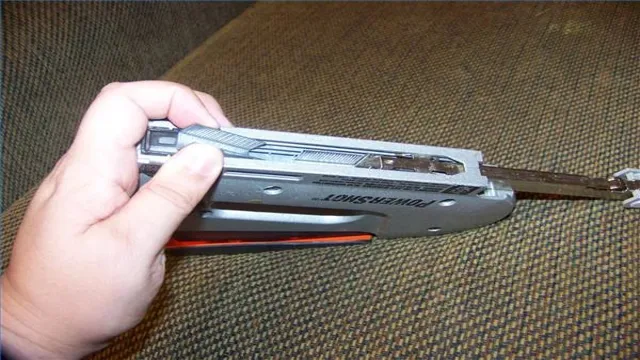
Prepare Your Staple Gun
Reloading your staple gun may seem intimidating at first, but with some practice, it can become an easy task. The first step is to prepare your staple gun by releasing any remaining staples and making sure the staple channel is clear. Next, locate the tab or button that releases the staple magazine and push it to open the magazine.
Then, insert the staples carefully and make sure they are straight and aligned. Finally, push the magazine back in until it clicks into place. It’s important to note that different staple guns have different loading mechanisms, so it’s always a good idea to refer to the user manual to avoid any mistakes or damage to the tool.
With these steps in mind, you’ll be able to quickly and effectively reload your staple gun, and get back to your project in no time.
Disconnect the Gun from Power
When preparing to use a staple gun, it’s essential to begin by disconnecting it from the power source. Whether you’re using a manual staple gun or an electric one, it’s always better to be safe than sorry. With an electric staple gun, this involves unplugging it from the electrical outlet or removing the battery, while with a manual staple gun, it means making sure that the spring mechanism is not under tension.
Failure to disconnect the staple gun from power could lead to accidental firing, which could cause injury or damage to your project. Moreover, leaving the staple gun connected to power when not in use is a safety hazard, especially if you have children around. Therefore, always remember to disconnect your staple gun from power when preparing to use it.
Remove Any Remaining Staples
Before using your staple gun, it is important to properly prepare it. Begin by removing any remaining staples from the gun. This not only ensures that your gun is functioning properly, but it also prevents any jamming that may occur due to leftover staples inside the gun.
To avoid potential injury, make sure to wear protective gloves and use pliers to remove any stubborn staples. Once all the staples have been removed, inspect the gun to ensure that there are no remaining staples or debris. With a clean and functioning staple gun, you can tackle your project with ease and efficiency.
Remember to always prioritize safety and proper preparation when using any tool to prevent any accidents or damage.
Load the Staples
If you’re a DIY enthusiast, you’ve probably encountered a staple gun at some point. Whether it’s for reupholstering furniture or attaching new shingles to your roof, a staple gun is a handy tool to have around. But, what happens when you run out of staples? Reloading a staple gun can seem like a daunting task, but it’s actually quite simple.
First, ensure that the staple gun is unplugged or has no power source attached. Next, locate the staple compartment and open it. Depending on the model, this may involve sliding a latch or pressing a release button.
Once the compartment is open, insert the staples with the pointed ends facing down. Double-check that you’ve loaded the right type and size of staple. Finally, close the compartment and test fire the staple gun to ensure it’s functioning properly.
With these simple steps, you’re now ready to load your staple gun like a pro and get back to your DIY projects in no time.
Open the Magazine Release
When it comes to loading staples into a staple gun, the first step is to open the magazine release. This can usually be found on the bottom of the staple gun and is a button or lever that you can press or flip. Once you’ve located it, press or flip it to open the magazine.
The magazine is where the staples are loaded and held in place. Next, grab a strip of staples and insert them into the magazine with the pointed ends facing down. Be sure to align them properly and not overfill the magazine to prevent jamming.
Once you’ve loaded the staples, close the magazine release to secure them in place. Congratulations, you’re now ready to start stapling! Remember to always follow safety guidelines and instructions provided by the manufacturer to ensure a successful and safe staple job.
Insert the New Staples
When it comes to stapling documents, it’s essential to have a stapler that’s loaded with the correct staples. Loading staples into a stapler may seem simple, but there are a few things to keep in mind. First, make sure you have the right size staples for your stapler.
Most staplers indicate the staple size required on the body or packaging. Next, locate the loading chamber on your stapler. This is usually located on the back of the stapler and can be accessed by pushing a button or sliding a cover.
Once you’ve opened the loading chamber, insert the staples with the pointed end facing down. Make sure you don’t overload the chamber, as this could cause jams or misfires. Finally, close the loading chamber and test your stapler on a scrap piece of paper to ensure it’s loaded correctly.
By following these simple tips, you can ensure your stapler is loaded with the correct staples for efficient and professional-looking documents.
Close the Magazine Release and Test the Gun
Now that you’ve loaded your staple gun, the next step is to close the magazine release. This is the part of the stapler that holds the staples in place. Make sure it is securely closed before you start using your stapler.
Once you’ve done that, it’s time to test the gun. Find a scrap piece of material or paper and place it beneath the stapler. Make sure the stapler is aligned with the surface and then squeeze the trigger.
If the staple comes out properly and is securely fastened, then you’re good to go. If it doesn’t come out at all, or if it’s loose, then you may need to adjust the gun. You might need to increase the pressure on the stapler, or adjust the depth of the staple.
With a little bit of trial and error, you should be able to find the right settings for your stapler, and then you’ll be ready to tackle those DIY projects in no time. Remember always to use the proper safety precautions when using any tools, and keep your stapler stored safely when not in use.
Make Sure the Release Is Fully Closed
When you’re finishing up your day at the shooting range, it’s important to make sure you’ve closed the magazine release before you pack up your gun. Although it may seem like a small detail, leaving the magazine release open can pose a safety risk. If the release is open, the magazine could fall out while you’re carrying the gun, potentially causing harm to yourself or others.
Additionally, an open release could lead to damage or wear and tear on the gun itself. Before you put your gun away for the day, take a moment to double-check that the magazine release is fully closed. You can then test the gun to make sure everything is functioning properly.
By taking these small precautions, you can help ensure the safety of yourself and those around you.
Staple a Few Times on Scrap Material
Before testing your gun, it’s essential to ensure that the magazine release is closed securely. If you have disassembled the gun for cleaning or modifications, the magazine release will be open. To close it, you can staple a few times on a scrap material.
Insert the stapler’s metal plate into the release hole, and it will make a clicking sound indicating that your magazine is now locked in place. Once you’ve done this, you can test your gun by attempting to pull out the magazine sharply. If it doesn’t budge, then your release is now working correctly.
Testing your gun after cleaning or maintenance is crucial for your safety as well as ensuring your firearm’s proper functioning. Always remember to double-check the magazine release before testing to prevent accidental discharge. With this simple tip, you can safely and confidently test your firearm knowing that it’s working correctly.
Conclusion: Why Proper Staple Gun Care Is Important
Reloading a staple gun may seem daunting at first, but with a little bit of practice and patience, it’s a snap! From loading the staples to adjusting the tension, it’s all about understanding the mechanics of your tool and taking the time to do it right. And once you’ve got it down, you’ll feel like a staple gun wizard, ready to tackle any DIY project that comes your way. So go forth, armed with your staple gun and staples, and let the stapling begin!”
FAQs
What is a staple gun used for?
A staple gun is a hand-held tool used to fasten or attach materials together using staples.
How do I reload a staple gun?
To reload a staple gun, first, open the magazine and remove any remaining staples from the previous strip. Then, insert a new strip of staples, making sure they are facing in the right direction. Close the magazine and test the stapler to ensure it is working properly.
What size staples should I use with my staple gun?
The size of staples depends on the type and model of your staple gun. Check the manufacturer’s instructions or packaging for the recommended staple size.
Why is my staple gun jamming?
Your staple gun may be jamming due to several reasons, such as using the wrong size or type of staple, overloading the magazine, or using damaged staples. Clear the jam and try again, ensuring you are using the correct staples and not overloading the magazine.
How do I adjust the depth of staples in my staple gun?
Many staple guns come with adjustable depth settings. Look for a dial or knob on your staple gun and turn it to adjust the depth of staples.
Can a staple gun be used on any material?
No, a staple gun may not be suitable for use on all materials. It works best on materials such as wood, fabric, and cardboard. Some staple guns may also have specific uses indicated by the manufacturer.
How do I prevent accidental firing of a staple gun?
To prevent accidental firing, always point the staple gun away from yourself and others when it is loaded. Keep your hand away from the trigger until you are ready to staple, and never leave the staple gun unattended when loaded.
